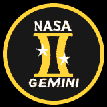|
| Mercury | Apollo | Skylab |

The Gemini Program was intended to be an intermediate step
between Mercury and Apollo. The Gemini spacecraft carried
two astronauts and it was the first spacecraft to use a
hydrogen fuel cell to generate electricity.
Gemini astronauts performed the first orbital rendezvous and
docking as well as the first American spacewalk. These
abilities would be required if a manned mission to the Moon
was to become a possibility. A land landing using Gemini was
scheduled, but that mission was cancelled in 1964.
By the time the Gemini Program ended in 1966 the Americans
were catching up with or even surpassing the Russians in the
space race.
Main Objectives
- Spend up to two weeks in orbit
- Rendezvous and dock with another spacecraft
- Perfect Earth re-entry and landing
Manned Missions
- Gemini 3 'Molly Brown'
March 23, 1965
Virgil "Gus" Grissom, John Young
- Gemini 4
June 3-7, 1965
James McDivitt, Edward White
- Gemini 5
August 21-29, 1965
L. Gordon Cooper, Charles "Pete" Conrad
- Gemini 7
December 4-18, 1965
Frank Borman, James Lovell
- Gemini 6A
December 15-16, 1965
Walter Schirra, Thomas Stafford
- Gemini 8
March 16, 1966
Neil Armstrong, David Scott
- Gemini 9
June 3-6, 1966
Thomas Stafford, Eugene Cernan
(Reassigned after the deaths of Elliot See and Charles Bassett)
- Gemini 10
July 18-21, 1966
John Young, Michael Collins
- Gemini 11
September 12-15, 1966
Charles "Pete" Conrad, Richard Gordon
- Gemini 12
November 11-15, 1966
James Lovell, Edwin "Buzz" Aldrin
|

